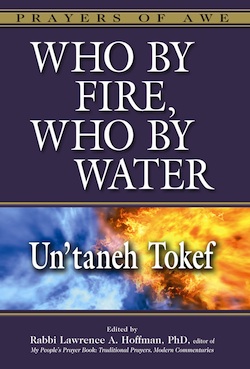By Rabbi Lawrence A. Hoffman, Special to JTNews
High on the list of Jewish martyr stories still retold or, at least, alluded to every Rosh Hashanah and Yom Kippur, is the terrible medieval tale of Rabbi Amnon of Mainz. For refusing to appear before the Bishop of Regensburg — who had requested that Amnon become a Christian — he had his limbs hacked off; what was left of him was arrayed alongside his severed parts and returned home in time for Rosh Hashanah.
As the chazzan reached the climax of services that day, Amnon interrupted with a beautiful liturgical poem, and was promptly transported to his heavenly abode. Three days later he appeared to the saintly Rabbi Kalonymos to teach him the poem and instruct him to spread it everywhere. Today, that poem, the Un’taneh Tokef, is a centerpiece of the High Holy Day liturgy.
So goes the story, which is still told annually in many a synagogue, before Un’taneh Tokef and its two-fold message: First, that “On Rosh Hashanah it is written and on Yom Kippur it is sealed: who will live and who will die, who by fire, who by water…who by earthquake, who by plague [and so forth]”; but second, that “penitence, prayer, and charity” can somehow alleviate the hardship of the decree.
It is hard to know which is more troubling: The prayer or the story of its authorship. Who by Fire, Who by Water (Jewish Lights Publishing, 2010), the first volume in the “Prayers of Awe” series, chronicles the fascinating controversy that surrounds them both. The problem with the prayer is that it seems patently scandalous.
Were the fates of the 9/11 victims predetermined on the prior Yom Kippur? Did they die because they were insufficiently penitent, prayerful, or charitable? The problem with the story is that it is hardly a message that inaugurates a new year with spiritual promise. Besides, it is pure fiction — there never was a Rabbi Amnon of Mainz. “aMNoN” is a rearrangement of the letters in the Hebrew Ne’eMaN, “faithful.” This is a morality tale of a putative “Rabbi Faithful” who stood fast in the face of adversity.
The poem was probably composed as early as the fifth or sixth century by a Byzantine Jewish genius named Yannai, who symbolized anything but Jewish martyrdom in the face of inhuman persecution. Yannai personified a Jewish literary efflorescence rarely matched in the millennium and a half following.
Perhaps the story we should be telling every Rosh Hashanah is the Jewish potential for artistic brilliance, Judaism as a well of creative potential, not Judaism as the religion of the persecuted masses. Un’taneh Tokef illustrates classic liturgical poetry at its best, an abundance of biblical and rabbinic allusions wed to clever Hebrew wordplay and alliterative excellence.
But what about the poem’s troubling message? While the first half of Who by Fire, Who by Water provides the truly stunning story behind the myth and the poem (alongside an annotated translation of both), the second half elicits commentaries from some 40 thoughtful contributors who tell us how they handle the poem’s message. Here, arguing over the poem’s merits, are rabbis and laypeople; men and women from all denominations of Jewish life (some of them artists, writers, scholars, teachers, and musicians); from around the world and spanning generations. Prayer book editors from Europe and North America wrangle over whether to include it, fudge its message, or trash it altogether.
Modern feminist and professor Wendy Zierler surveys Un’taneh Tokef as a theme in modern literature. Israeli professor Dalia Marx recalls how the poem emerged anew as a symbol of Israelis dying in the Yom Kippur War of her youth. Bible professor Marc Brettler provides the biblical backdrop for the poem, and several writers subject it to literary analysis, exposing its very many poetic virtues. Author and scholar Erica Brown plays with the image of God as writer of our fate: What kind of writing would God prefer? Fiction? Journalism? Scholarship?
“Who shall live and who shall die? The answer is ‘Me!’” concludes Rabbi Edward Feinstein, in his insistence that Un’taneh Tokef speaks directly to our most cherished illusion — that we are in charge of our fate, when, in fact, we are painfully out of control.
Isn’t that the whole point of the High Holy Days, delivered, in Rabbi David Stern’s judgment, “with the poetic force of a two-by-four”?
But still, does God really work that way? Does the God of Judaism write real-life obituaries in advance, not just fiction, journalism, or whatever? No, says Rabbi Delphine Horveilleur of Paris, the very idea is unpalatable. The poem’s theology is “infantilizing.” But it is a poem, with all the complexities of Shakespeare, Keats, or Cummings, and requiring all the interpretation they do.
It may not even be about God at all, so much as it is about us! Perhaps the poem’s real climactic claim is that even though “our origin is dust and our end is dust,” we yet carry God’s name in our very being — ”We are part of something everlasting,” says Rabbi Sandy Eisenberg Sasso.
Both the poem’s authorship and its message matter profoundly. Which Jewish type we emphasize, Amnon the martyr or Yannai the poet, will determine what Judaism we hand on to the next generation. The dizzying panoply of commentaries gathered here ask and answer the core religious questions of our time: Who is God? What is fate? How do humans matter? What spiritual truths can carry us forward when mortality’s harsh reality becomes finally unavoidable?
Rabbi Lawrence A. Hoffman, Ph.D., the Barbara and Stephen Friedman Professor of Liturgy, Worship and Ritual at Hebrew Union College–Jewish Institute of Religion, is editor of the My People’s Prayer Book: Traditional Prayers, Modern Commentaries series, winner of the National Jewish Book Award, and the major new series Prayers of Awe, which explores the High Holy Day liturgy. He is author of many works that enrich Jewish life today.
